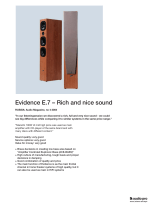
balanced XLR socket. Running fully
balanced greatly reduces hum and
noise of all forms; its preferable to all
else both in theory and in practice I
have found.
In addition to three turntable
inputs, there are two Line inputs;
Line 1 is through phono sockets
(unbalanced) and Line 2 through XLR
balanced) sockets. Using phono or
XLR in-to-out there is no gain; phono
input to XLR out gives x2 gain; XLR
in to phono out gives x0.5. Line in
does go to Digital out as well.
Unbalanced phono socket
outputs and balanced XLR outputs
are fitted, measurement showing the
latter give twice the output of the
former, effectively doubling quoted
gain values.
Surprisingly, there are digital
outputs too, so you can rip LPs to
digital files. Appropriately, McIntosh
fit a high resolution 24/192 Analogue-
to-Digital convertor. Both USB and
S/PDIF digital are available, the latter
via phono-socket electrical and
TOSLINK optical connectors, as is
common.
A disappointment was lack of
an on-board volume control, so
the MP1100 must be used with
a pre-amplifier, increasing system
complexity and cost – even though
it has enough gain to drive a power
amplifier direct. It does however,
have a remote control that allows
cartridge loadings and gains to be
adjusted from the listening position.
Size wise, this is a substantial unit,
designed to fit a 19in rack – which
hi-fi racks all are. It is therefore
18in wide (457mm), 445mm deep
and 152mm high. Weight is high at
12kgs, with plenty of heavy sheet
steel used in the case work; the top
cover was unusual heavy I found. The
bottom of the case is stainless steel
and carries power supplies,
and a digital section,
effectively shielding these
components from the
sensitive analogue stages
above. Build quality
and finish are very good,
and as always we have
the company’s particular
styling, with blue display
readouts, blue illuminated
output meters and big
rotary knobs.
Curiously sited on
top of the cabinet in a
window lie the valves, four
12AX7 double-triodes. Since you
can’t do all the MP1100 does with
just four 12AX7s there had to be
unmentioned transistors inside and
indeed I found numerous N5532
low noise audio chips clustered
around the phono inputs, on a large,
robotically produced circuit board
bristling with miniature surface
mount (SMD) parts, accompanied
by an army of sealed relays. They
contribute substantially to a stable
and reliable product, in this case
switching all the many options the
unit possesses. The valves it would
seem are used in intermediate stages,
since dedicated silicon chip input and
output stages cost less and perform
better.
IN USE
Switching on, the McIntosh pauses
whilst the valves warm up, LEDs
beneath them glowing orange. When
ready to go their colour changes
to green. For those that dislike
valve lighting, the display can
be switched off. Mains power
consumption is 50 Watts;
we ran the unit from an
Isotek Evo3 150 Watt mains
regenerator. There was no
switch on noise, such as
clicks or thumps.
There are five gain settings:
40dB and 46dB are for high
and low output MMs; 52dB
(x400) is for high output
MCs, whilst 58dB and 64dB
are for conventional and very low
output MCs respectively. Technically,
it’s best to use lowest gain possible
and turn volume up, by the way,
because this lessens the likelihood of
overload, but the MP1100 has a clip
warning indicator to warn of this if
the unit is mis-set, and the meters
provide similar warning. I used 58dB
for an Ortofon A95 MC cartridge
and 40dB for Ortofon 2M Black MM.
Input impedance can be set at
25, 50, 100, 400 and 1k Ohms for
MCs and 47k for MMs. MCs (moving
coils) should be set according to the
cartridge manufacturer’s instructions,
most being designed for 100 Ohms,
but MMs (moving magnets) need a
47k load.
Input capacitance loading can
This is a massively complex phono stage complete with micro-
processor controlled switching via relays, seen as oblong black
objects on the board. Much of the board uses miniature sur
-
face-mount (SMD) parts and it is robotically manufactured.
12AX7 (ECC83) double-triodes
are used as amplifiers in fully
balanced circuitry. These
have a 10,000 hour life and
are cheap to replace should it
be necessary (unlikely).
www.hi-fiworld.co.uk JULY 2017 HI-FI WORLD
VINYL SECTION
HI-FI WORLD
HI-FI WORLD









